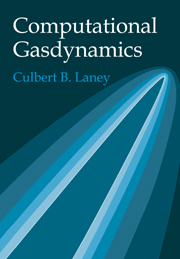Chapter 1 - Introduction
Published online by Cambridge University Press: 07 December 2009
Summary
Fluid dynamics concerns fluid motions. No single book, or even shelf of books, could hope to describe the full range of known fluid dynamics. By tradition, introductory books mainly concern three simplified categories of flow:
Gasdynamics – compressible frictionless flows.
Viscous flows, boundary layers, and turbulence – incompressible frictional flows.
Potential flows – irrotational frictionless flows.
Books with generic titles like fluid dynamics, fluid mechanics, or aerodynamics generally survey all three basic categories of flow. Other books concern just gasdynamics or just viscous flows. These books sacrifice breadth for depth. Given the huge differences between compressible inviscid flows and viscous incompressible flows, single-topic treatments make sense for many readers, who need to know only one or the other.
Computational fluids dynamics (CFD) concerns computer simulations of fluid flows. Each type of fluid flow listed above has inspired a myriad of competing numerical methods, each with its own pros and cons, each demanding a good understanding of both traditional fluid dynamics and numerical analysis. As a result, the size of computational fluid dynamics far exceeds that of traditional fluid dynamics. At the present time, most CFD books survey numerical methods for all three of the basic flow categories. While such surveys work well for traditional fluid dynamics, the larger size of CFD requires more compromises and trade-offs. With so much to cover, even a two-volume survey can only describe the basic principles and techniques common to all three categories of flows, plus a limited and sometimes arbitrary sampling of the principles and techniques specific to each category of flow.
- Type
- Chapter
- Information
- Computational Gasdynamics , pp. 1 - 2Publisher: Cambridge University PressPrint publication year: 1998
- 30
- Cited by



